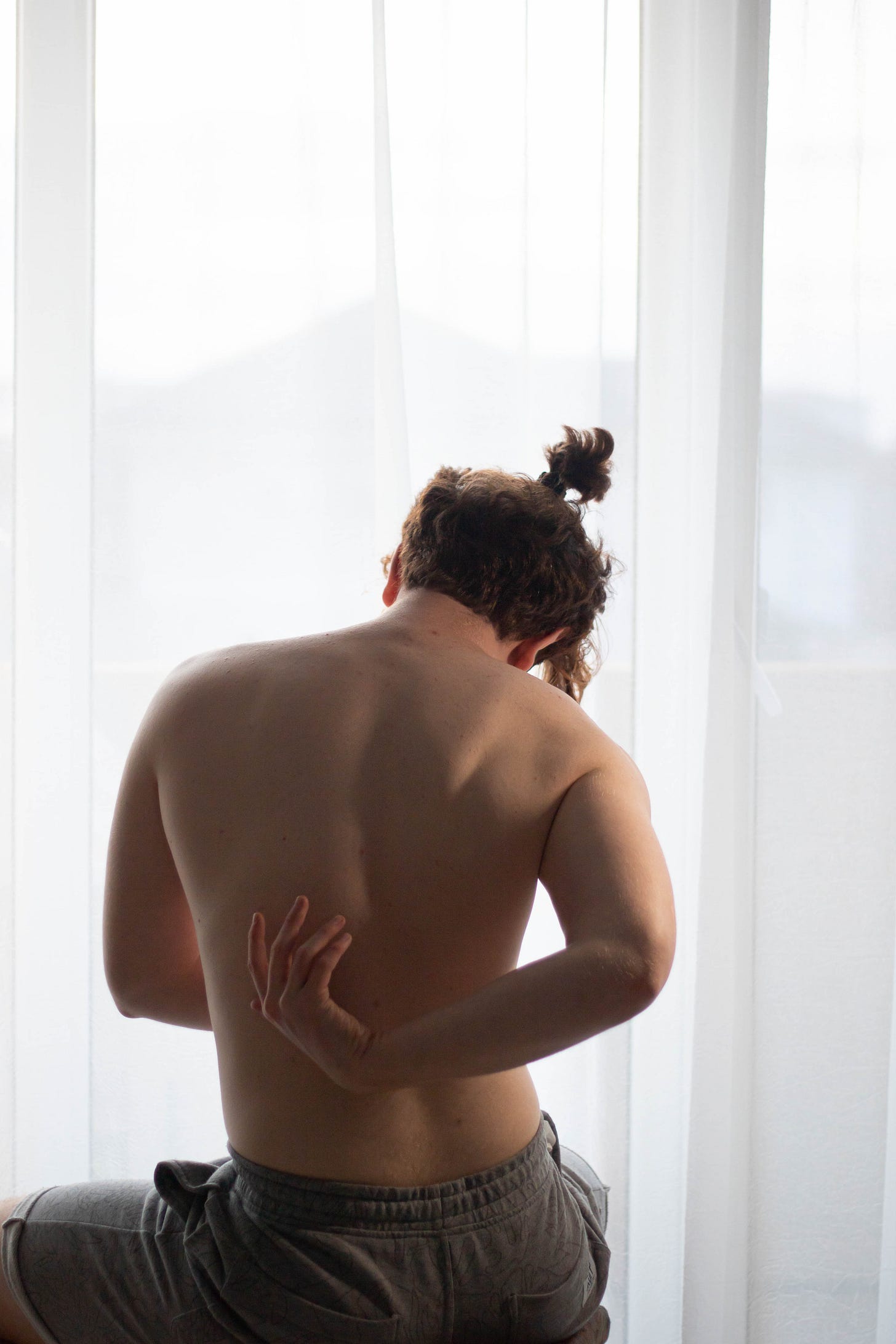Our back is a miracle of the interplay of the bony spine, muscles, tendons and ligaments as well as the fascial connective tissue. It stabilises us upright against gravity and at the same time is so flexible that we can bend, stretch, tilt and rotate. But what do we do if it still hurts? 80 percent of back pain is unspecific, has no clear cause and can be quickly controlled through your own activity.
A holistic approach to back health
A strong back with safety
Back-friendly lifting and carrying
Back pain - what role does the psyche play?
Various factors have an impact on the condition and health of our back. Let's look at them a little closer.
Biological Influences
Age
Height and weight
Gender
Pre-existing conditions
Exercise and sport in everyday life
Pain thresholds
Ergonomic influences
Workplace design
Back-friendly working
Dynamic sitting
Regular alternation between sitting and standing
Targeted activities at the workplace
Social & psychological influences
Environmental conditions
Professional and private satisfaction
Social embedding (community)
Positive or negative mood
Stress levels
Emotional stability
Preventive / curative influences
Massages / physical therapy
Physiotherapy / Osteopathy
Acupuncture / foot reflex zone therapy
Alternating showers
Exercise therapy
Back health trough exercise
Why is movement so important?
By alternating between tension and and relaxation, the musculature is better supplied with nutrients.
Tendons and ligaments are strengthened by movement.
The joints are protected.
Muscle mass can build up.
Nerve pathways and connections between nerve cells are longer.
Exercise releases endorphins and and these provide a good mood.
What exercise is good for you?
Everything ;-) - Please try it out!
Dancing
Yoga, Pilates
Tai Chi, Qi Gong
Nordic Walking, Walking
Ball and movement games
Barefoot walking on on different surfaces
Gymnastics
Swimming
Balancing, Slackline
What to do for back pain?
2-3 days of light movements and possibly support with heat/ massage.
Move "as normally as possible".
Alternating showers.
In case of severe pain, paraesthesia or paralysis, consult a doctor.
Start slowly with walks and light back exercises.
Try out what feels good and slowly expand the range of movement.
A strong back for sure
Unergonomic posture, repetitive one-sided movements, heavy lifting or carrying loads and sitting for too long can all lead to damage to the back. The following measures protect your back.
Regular breaks
To relieve the strain on the back and to recharge your batteries.
Changing activities and positions during breaks.
Lifting and carrying loads
Use of aids, such as lifting aids or hand trolleys.
Requesting support.
Physical activity
Regular physical activity strengthens the back and prevents injuries.
Sport helps to build up muscles and relieve tension.
Training and further education
Knowledge in handling heavy loads, ergonomic workplace design and healthy behaviour in dealing with the back.
Ergonomic workplace design
According to the individual needs of the employees.
Adjust desk, chair, monitor and keyboard to the appropriate height and position.
To relieve the strain on the back and to recharge the batteries
Changing activities and positions during breaks
Lifting and carrying loads
Use of aids, such as lifting aids or hand trolleys.
Ask for support Physical activity.
Regular physical activity strengthens the back and prevents injuries.
Sport helps build muscles and reduce tension Training and further education.
Knowledge in handling heavy loads, ergonomic workplace design and healthy healthy behaviour in dealing with the back.
Back-friendly lifting and carrying
Stand close to the load and ensure that you have a stable standing position position to enable safe lifting and carrying.
Bend your knees and squat down to pick up the load or take a step position to do so. Assume a step position to do this. Avoid bending forward and curving your spine.
Grasp the load with both hands and hold it close to your body to minimise the strain on your back. minimise the strain on your back.
Keep your back upright and your shoulders back to ensure an ergonomic posture.
Use your arm and leg muscles to lift and pick up the load. pick up the load. Grasp the load and place it on one or both thighs using your arm muscles. Use your legs to push yourself upwards.
Hold the load instead of lifting it.
Avoid twisting and stay in your centre.
lift and carry consciously and avoid quick movements.
See here how this works in motion
Back pain - what role does the psyche play?
If the psyche is out of balance, then the health of the back also starts to falter. According to this, the triggers for back pain are frequently psychological factors such as stress, anxiety, depression, etc., in combination with factors such as one-sided strain, too little exercise and prolonged sitting.
Stress can put our bodies on alert, leading to increased muscle tone. From a physiological point of view, this makes sense in order to be able to deal with psychological factors such as stress, anxiety, depression, etc. in combination with factors such as one-sided heavy workloads, too little exercise and prolonged sitting.
If the muscles are in a tense state for a longer period of time because of permanent stress, the muscles can harden and subsequent back pain may result from it.
In order to prevent back pain, it is important to eliminate pathogenic psychological attitude, such as perfectionist, self-deprecating or negative thinking, and to reduce negative thinking, and to keep to one's own stress limits.
Ultimately, stress is a purely subjective evaluation process - how much or how little we feel can be influenced by our own stress evaluation matrix.
Exercises
Eercises can play a crucial role in strengthening the muscles, improving flexibility, and maintaining proper posture, all of which can help prevent back pain. Here are some exercises that are generally recommended for back pain prevention:
Planks: Planks engage the core muscles, including those in the lower back, helping to stabilize the spine and improve overall posture.
Bird Dog: This exercise targets the deep core muscles and the muscles along the spine. It helps improve balance, stability, and back strength.
Bridges: Bridges strengthen the glutes and lower back muscles, which are essential for maintaining proper alignment and reducing stress on the spine.
Cat-Camel Stretch: This stretch helps improve spinal mobility and flexibility. Begin on your hands and knees, arching your back like a cat, and then lower your belly and lift your head, creating a concave curve like a camel.
Superman: Lie face down on the floor with your arms extended in front of you. Lift your arms, chest, and legs off the ground simultaneously, engaging your lower back muscles. This exercise helps strengthen the back extensors.
Pelvic Tilts: Lie on your back with knees bent and feet flat on the floor. Gently tilt your pelvis to flatten your lower back against the floor, then tilt it in the opposite direction, arching your lower back slightly. This exercise helps improve awareness of pelvic alignment.
Hip Flexor Stretch: Tight hip flexors can contribute to lower back pain. Stretching these muscles can help alleviate tension. Kneel on one knee, while the other leg is bent in front of you at a 90-degree angle. Lean forward, keeping your back straight, until you feel a stretch in the front of your hip.
Hamstring Stretch: Tight hamstrings can affect posture and put strain on the lower back. Stretching them regularly can help relieve stress. Sit on the floor with one leg extended in front and the other bent with the sole of the foot against the inner thigh. Lean forward, reaching toward your toes while keeping your back straight.
Find even more helpful exercises in this video
It's important to note that before starting any exercise program, especially if you have existing back pain or medical conditions, it's advisable to consult with a healthcare professional or a qualified physical therapist. They can provide personalized guidance and tailor an exercise program to your specific needs.





Wow! What a well-founded and still concise summary. It cerainly reminded me about the good habits we so often tend to forget about and also taught me some new ones. Alternating showers against back pain... Certainly gonna try that one next time! Thanks a lot!